MERCEDES-BENZ E-CLASS COUPE 2015 Owner's Guide
Manufacturer: MERCEDES-BENZ, Model Year: 2015, Model line: E-CLASS COUPE, Model: MERCEDES-BENZ E-CLASS COUPE 2015Pages: 345, PDF Size: 11.42 MB
Page 31 of 345
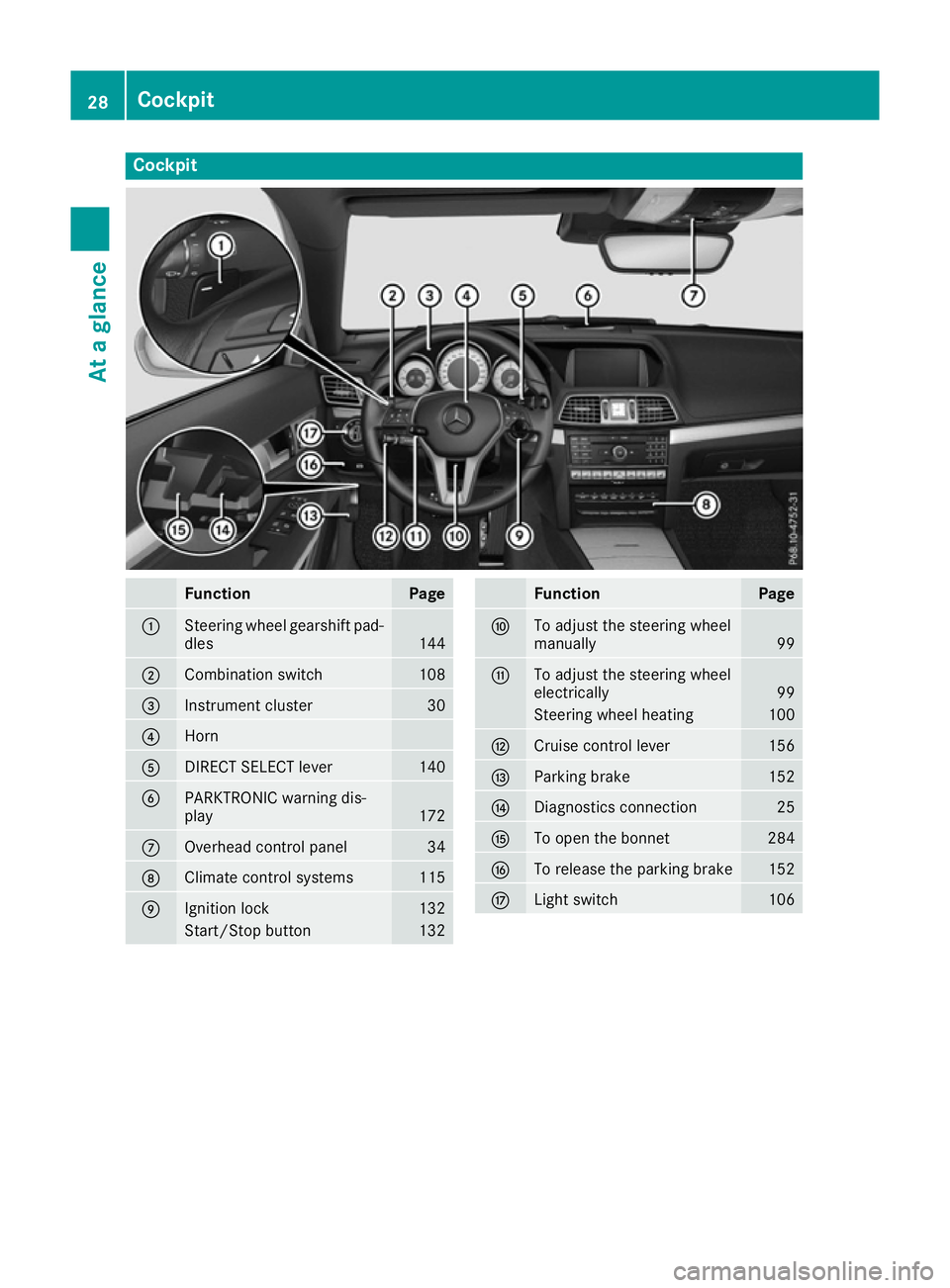
Cockpit
Function Page
:
Steering wheel gearshift pad-
dles 144
;
Combination switch 108
=
Instrument cluster 30
?
Horn
A
DIRECT SELECT lever 140
B
PARKTRONIC warning dis-
play
172
C
Overhead control panel 34
D
Climate control systems 115
E
Ignition lock 132
Start/Stop button 132 Function Page
F
To adjust the steering wheel
manually
99
G
To adjust the steering wheel
electrically
99
Steering wheel heating 100
H
Cruise control lever 156
I
Parking brake 152
J
Diagnostics connection 25
K
To open the bonnet 284
L
To release the parking brake 152
M
Light switch 10628
CockpitAt a glance
Page 32 of 345
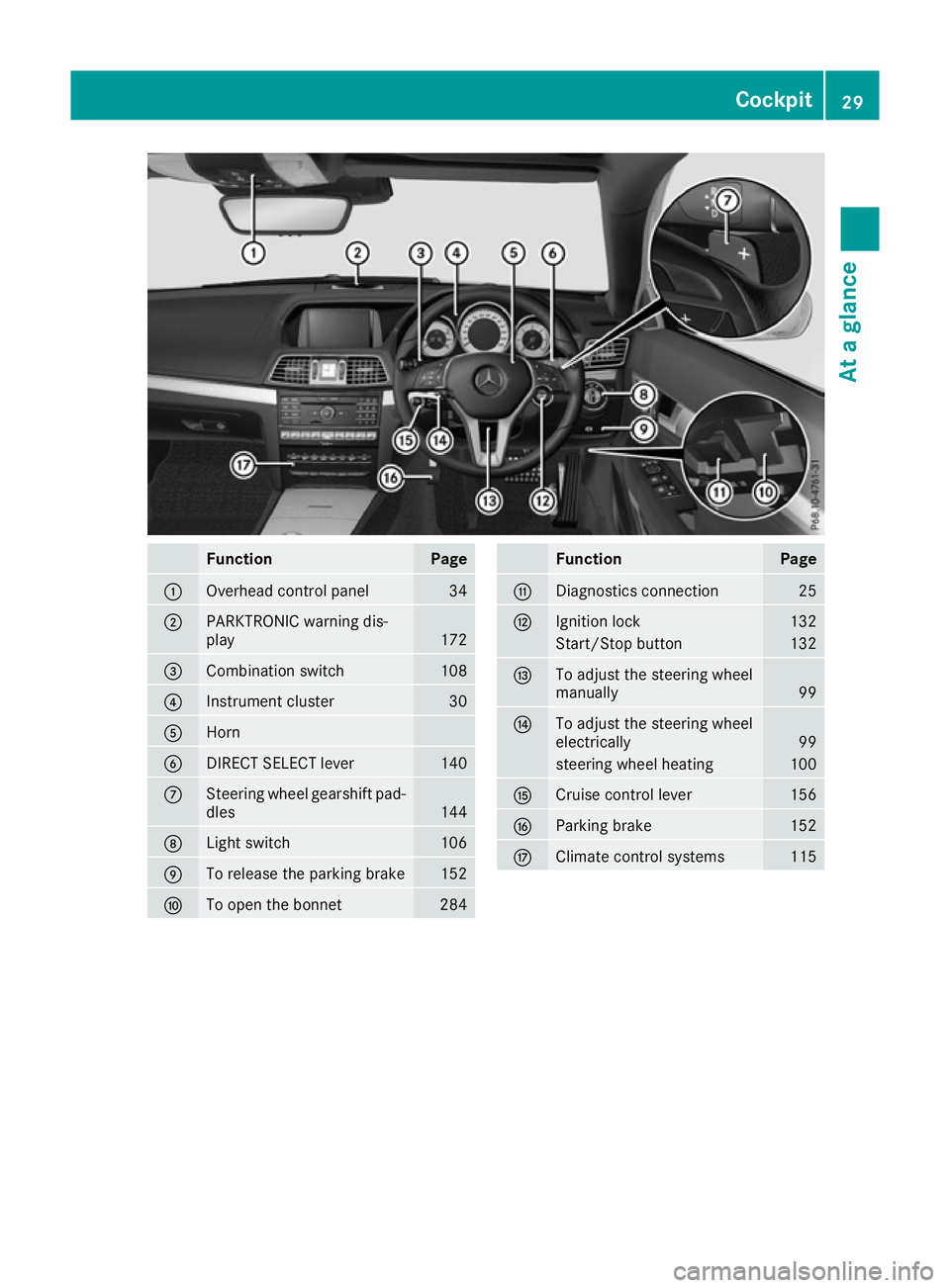
Function Page
:
Overhead control panel 34
;
PARKTRONIC warning dis-
play
172
=
Combination switch 108
?
Instrument cluster 30
A
Horn
B
DIRECT SELECT lever 140
C
Steering wheel gearshift pad-
dles 144
D
Light switch 106
E
To release the parking brake 152
F
To open the bonnet 284 Function Page
G
Diagnostics connection 25
H
Ignition lock 132
Start/Stop button 132
I
To adjust the steering wheel
manually
99
J
To adjust the steering wheel
electrically
99
steering wheel heating 100
K
Cruise control lever 156
L
Parking brake 152
M
Climate control systems 115Cockpit
29At a glance
Page 33 of 345
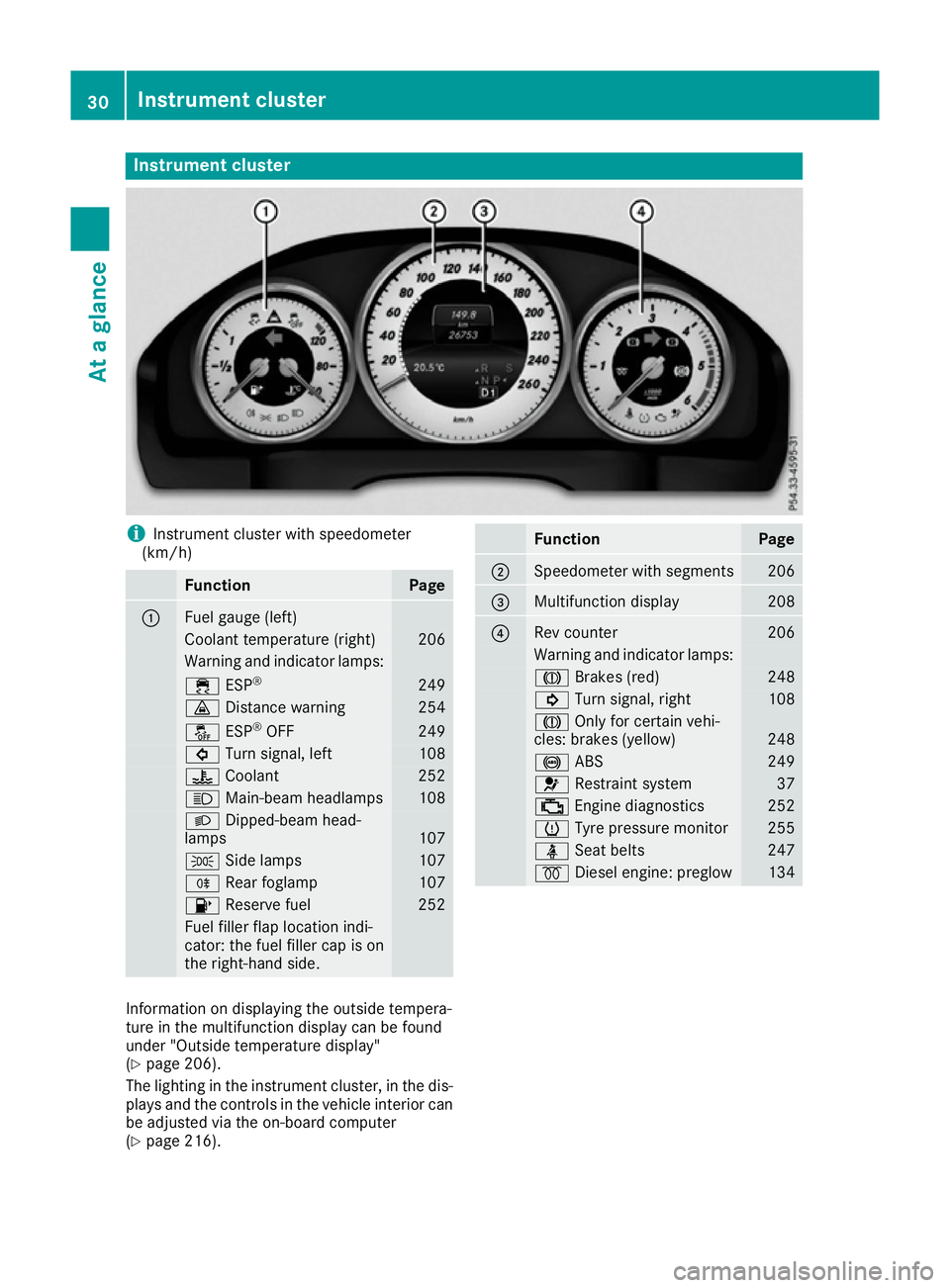
Instrument cluster
i
Instrument cluster with speedometer
(km/h) Function Page
:
Fuel gauge (left)
Coolant temperature (right) 206
Warning and indicator lamps:
÷
ESP® 249
·
Distance warning 254
å
ESP®
OFF 249
#
Turn signal, left 108
?
Coolant 252
K
Main-beam headlamps 108
L
Dipped-beam head-
lamps 107
T
Side lamps 107
R
Rear foglamp 107
8
Reserve fuel 252
Fuel filler flap location indi-
cator: the fuel filler cap is on
the right-hand side. Function Page
;
Speedometer with segments 206
=
Multifunction display 208
?
Rev counter 206
Warning and indicator lamps:
J
Brakes (red) 248
!
Turn signal, right 108
J
Only for certain vehi-
cles: brakes (yellow) 248
!
ABS 249
6
Restraint system 37
;
Engine diagnostics 252
h
Tyre pressure monitor 255
ü
Seat belts 247
%
Diesel engine: preglow 134
Information on displaying the outside tempera-
ture in the multifunction display can be found
under "Outside temperature display"
(Y
page 206).
The lighting in the instrument cluster, in the dis- plays and the controls in the vehicle interior can
be adjusted via the on-board computer
(Y page 216). 30
Instrument clusterAt a glance
Page 34 of 345

Multifunction steering wheel
Function Page
:
Multifunction display 208
;
Multimedia system display
= ?
Switches on voice-operated
control for navigation or LIN-
GUATRONIC ? ~
Rejects or ends a call 212
Exits the telephone book/
redial memory
6
Makes or accepts a call
Switches to the redial mem-
ory
WX
Adjusts the volume
8
Mute Function Page
A
=;
Selects a menu 207
9:
Selects a submenu or scrolls
through lists 207
a
Confirms the selection 207
Hides display messages 222
B %
Back 207
Switches off voice-operated
control for navigation or LIN-
GUATRONIC i
You can find further information in vehicles
with a COMAND Online multimedia system:
R on the multimedia system in the Digital
Owner's Manual
R on LINGUATRONIC in the separate operat-
ing instructions i
You can find further information in vehicle
with an Audio 20 multimedia system:
R on the multimedia system in the Digital
Owner's Manual
R on voice-controlled navigation in the man-
ufacturer's operating instructions Multifunction steering wheel
31At a glance
Page 35 of 345
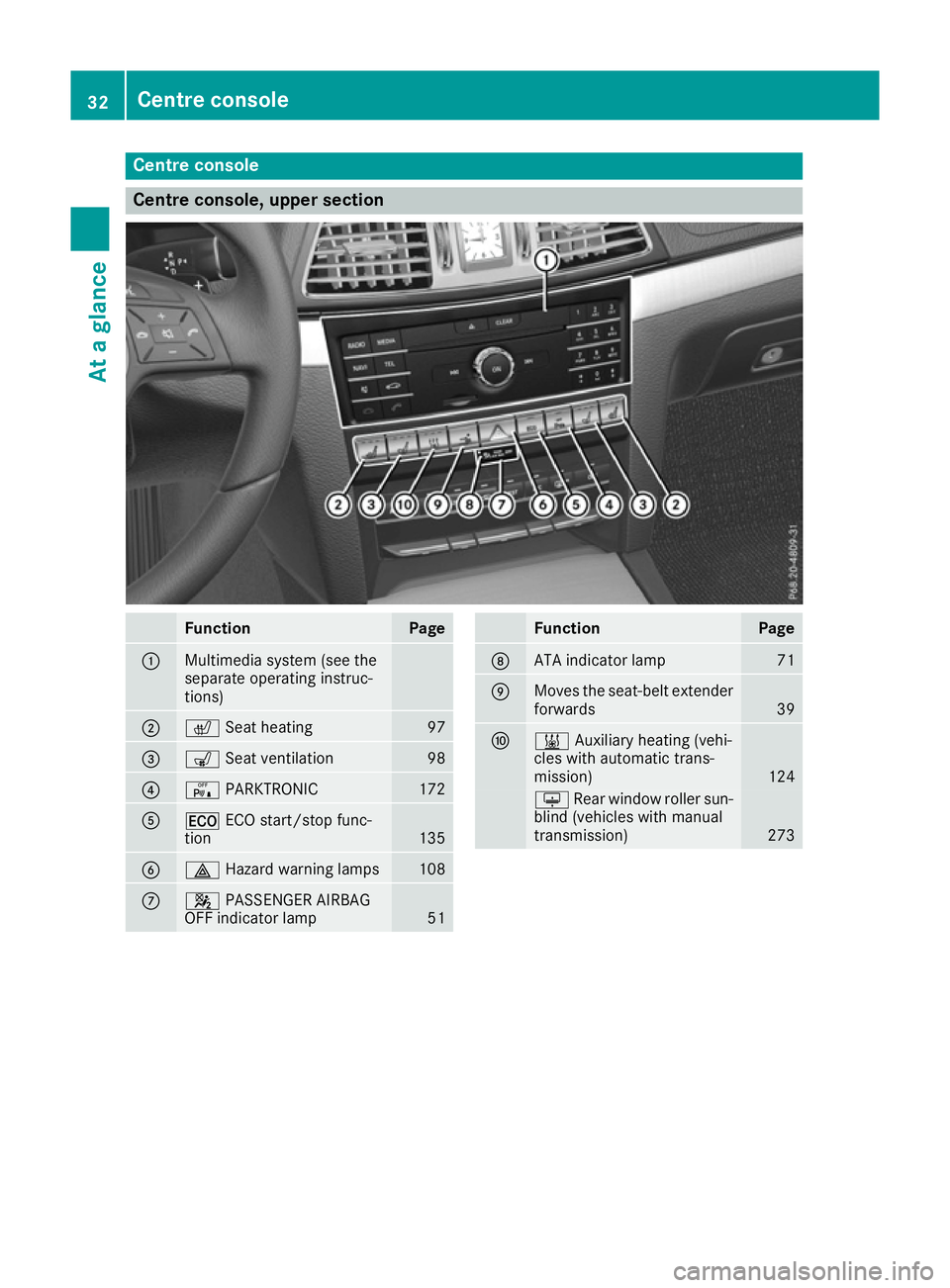
Centre console
Centre console, upper section
Function Page
:
Multimedia system (see the
separate operating instruc-
tions)
;
c
Seat heating 97
=
s
Seat ventilation 98
?
c
PARKTRONIC 172
A
¤
ECO start/stop func-
tion 135
B
£
Hazard warning lamps 108
C
4
PASSENGER AIRBAG
OFF indicator lamp 51 Function Page
D
ATA indicator lamp 71
E
Moves the seat-belt extender
forwards 39
F
&
Auxiliary heating (vehi-
cles with automatic trans-
mission) 124
u
Rear window roller sun-
blind (vehicles with manual
transmission) 27332
Centre consoleAt a glance
Page 36 of 345
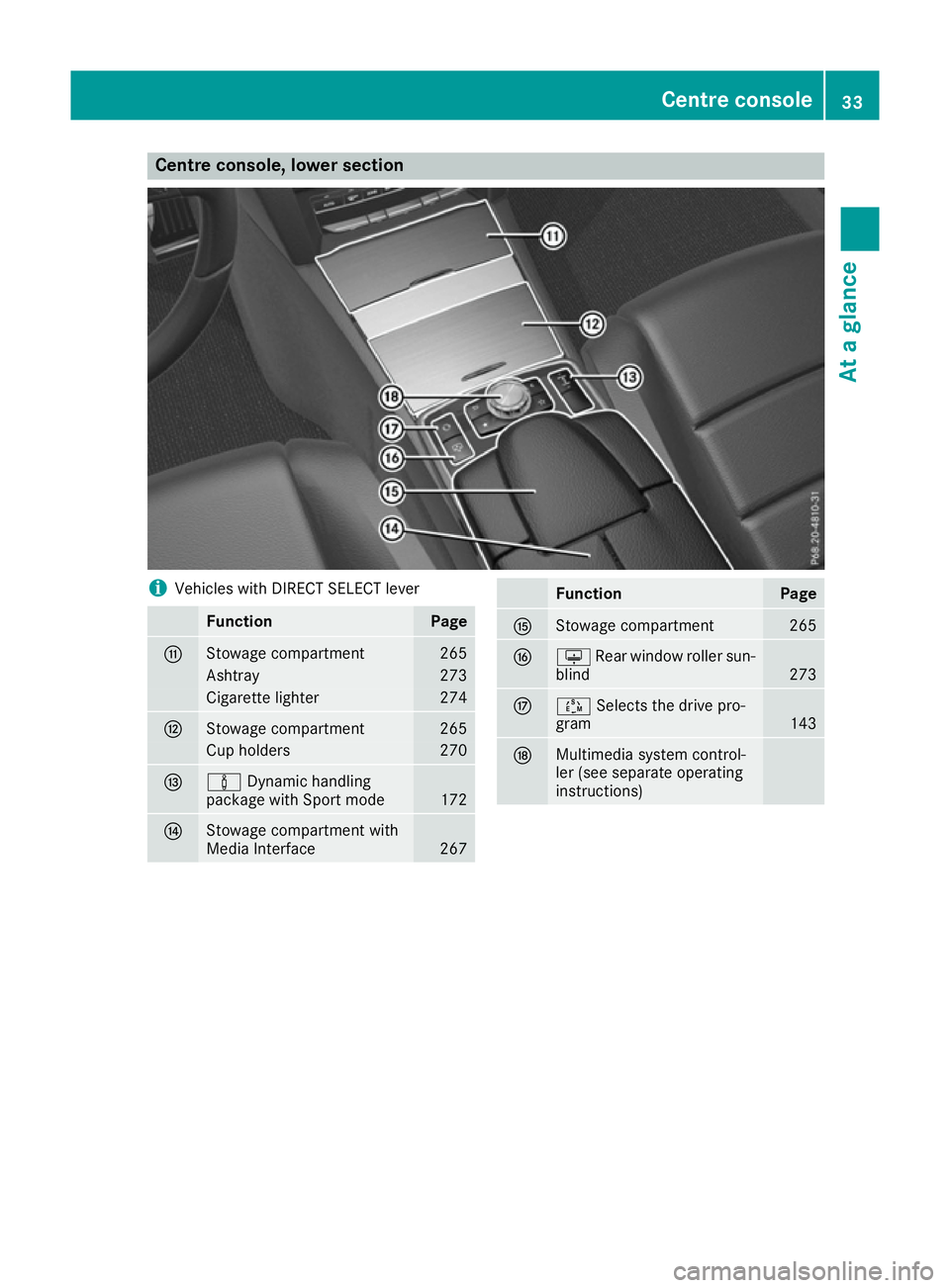
Centre console, lower section
i
Vehicles with DIRECT SELECT lever Function Page
G
Stowage compartment 265
Ashtray 273
Cigarette lighter 274
H
Stowage compartment 265
Cup holders 270
I
à
Dynamic handling
package with Sport mode 172
J
Stowage compartment with
Media Interface
267 Function Page
K
Stowage compartment 265
L
u
Rear window roller sun-
blind 273
M
Ú
Selects the drive pro-
gram 143
N
Multimedia system control-
ler (see separate operating
instructions) Centre console
33At a glance
Page 37 of 345
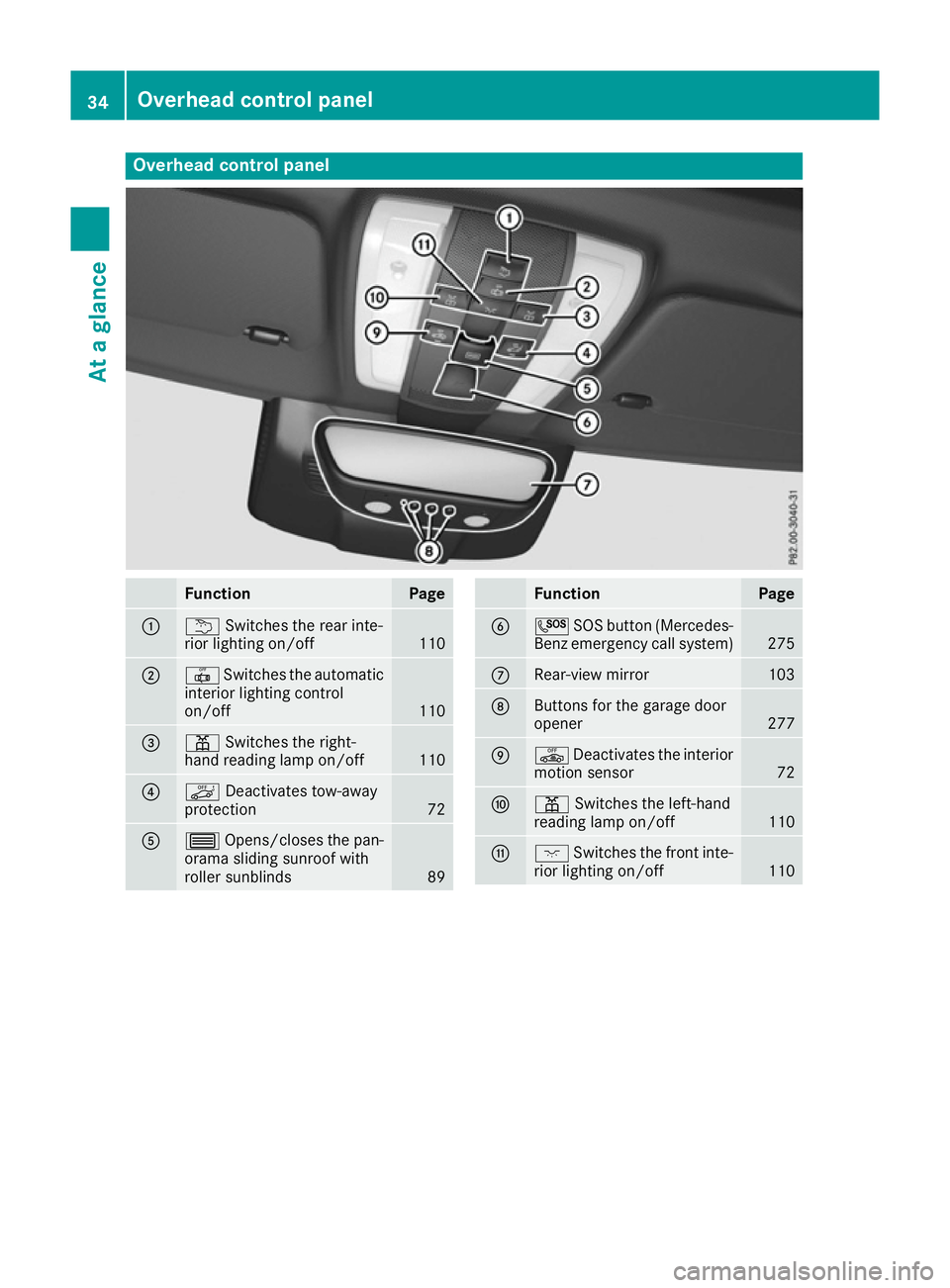
Overhead control panel
Function Page
:
u
Switches the rear inte-
rior lighting on/off 110
;
|
Switches the automatic
interior lighting control
on/off 110
=
p
Switches the right-
hand reading lamp on/off 110
?
ë
Deactivates tow-away
protection 72
A
3
Opens/closes the pan-
orama sliding sunroof with
roller sunblinds 89 Function Page
B
G
SOS button (Mercedes-
Benz emergency call system) 275
C
Rear-view mirror 103
D
Buttons for the garage door
opener
277
E
ê
Deactivates the interior
motion sensor 72
F
p
Switches the left-hand
reading lamp on/off 110
G
c
Switches the front inte-
rior lighting on/off 11034
Overhead control panelAt a glance
Page 38 of 345
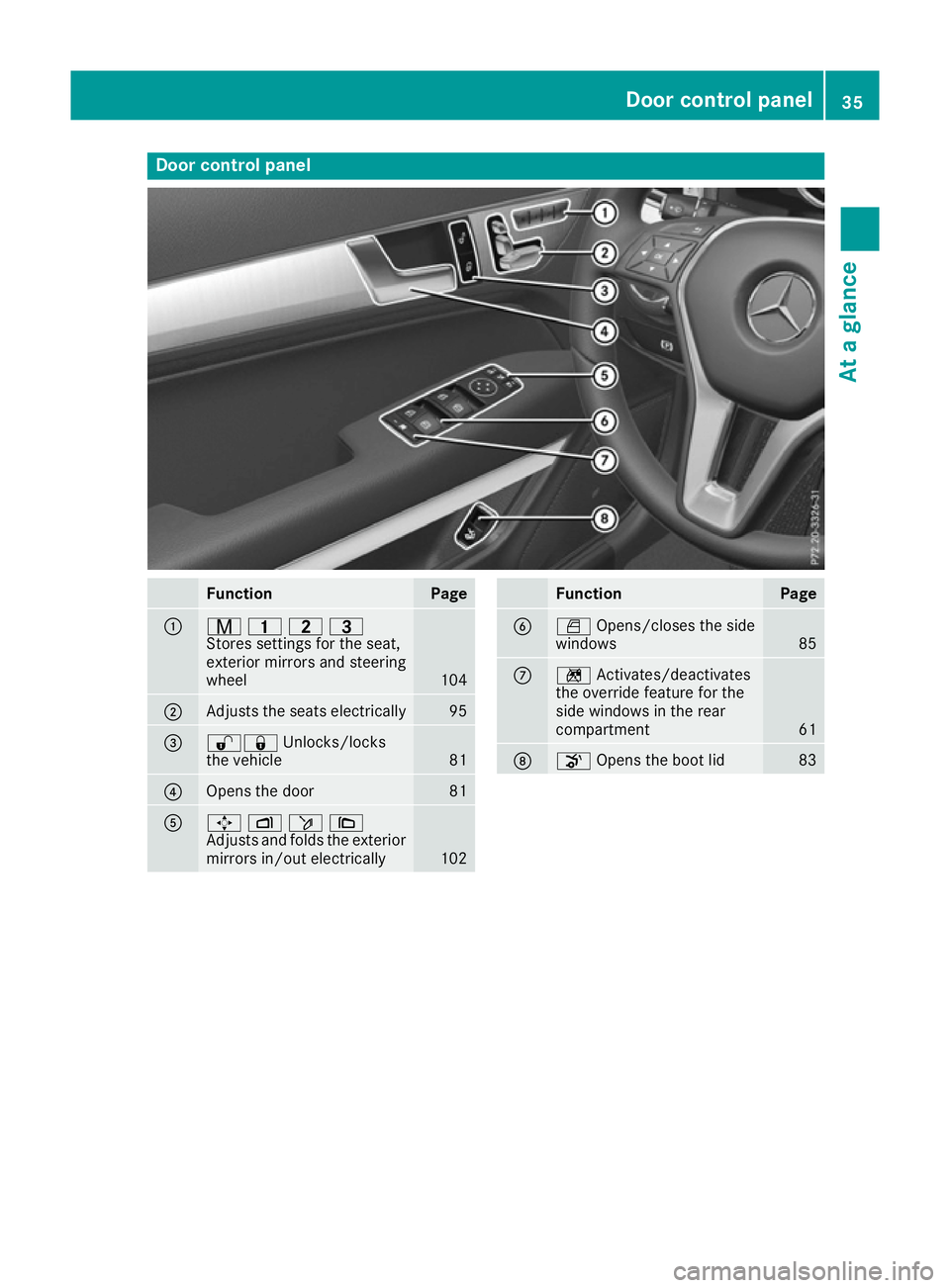
Door control panel
Function Page
:
r
45=
Stores settings for the seat,
exterior mirrors and steering
wheel 104
;
Adjusts the seats electrically 95
=
%&
Unlocks/locks
the vehicle 81
?
Opens the door 81
A
7
Zö\
Adjusts and folds the exterior
mirrors in/out electrically 102 Function Page
B
W
Opens/closes the side
windows 85
C
n
Activates/deactivates
the override feature for the
side windows in the rear
compartment 61
D
o
Opens the boot lid 83Door control panel
35At a glance
Page 39 of 345
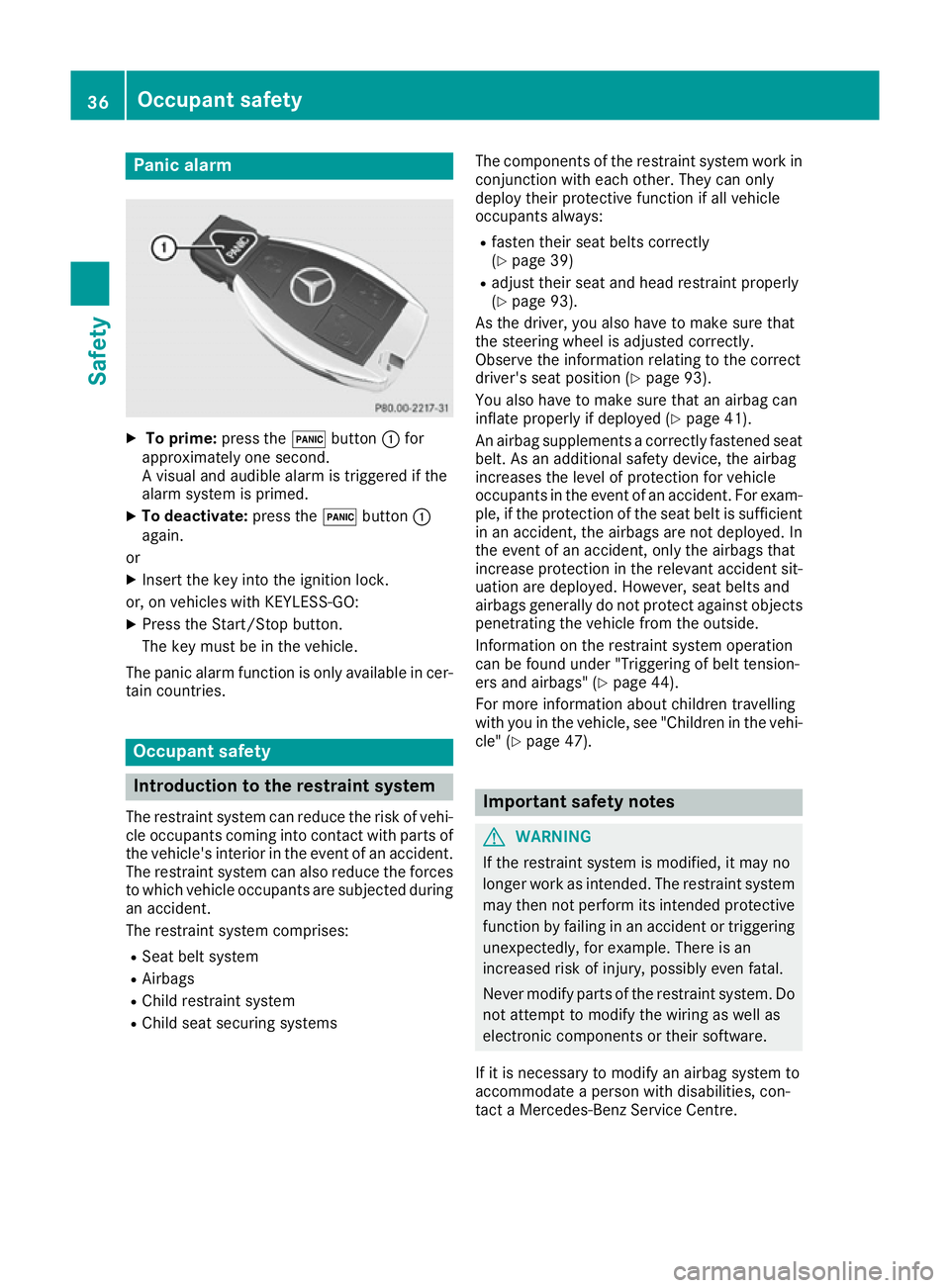
Panic alarm
X
To prime: press the!button :for
approximately one second.
A visual and audible alarm is triggered if the
alarm system is primed.
X To deactivate: press the!button :
again.
or
X Insert the key into the ignition lock.
or, on vehicles with KEYLESS‑GO: X Press the Start/Stop button.
The key must be in the vehicle.
The panic alarm function is only available in cer- tain countries. Occupant safety
Introduction to the restraint system
The restraint system can reduce the risk of vehi- cle occupants coming into contact with parts of
the vehicle's interior in the event of an accident.
The restraint system can also reduce the forces to which vehicle occupants are subjected during
an accident.
The restraint system comprises:
R Seat belt system
R Airbags
R Child restraint system
R Child seat securing systems The components of the restraint system work in
conjunction with each other. They can only
deploy their protective function if all vehicle
occupants always:
R fasten their seat belts correctly
(Y page 39)
R adjust their seat and head restraint properly
(Y page 93).
As the driver, you also have to make sure that
the steering wheel is adjusted correctly.
Observe the information relating to the correct
driver's seat position (Y page 93).
You also have to make sure that an airbag can
inflate properly if deployed (Y page 41).
An airbag supplements a correctly fastened seat belt. As an additional safety device, the airbag
increases the level of protection for vehicle
occupants in the event of an accident. For exam-
ple, if the protection of the seat belt is sufficient in an accident, the airbags are not deployed. In
the event of an accident, only the airbags that
increase protection in the relevant accident sit- uation are deployed. However, seat belts and
airbags generally do not protect against objects penetrating the vehicle from the outside.
Information on the restraint system operation
can be found under "Triggering of belt tension-
ers and airbags" (Y page 44).
For more information about children travelling
with you in the vehicle, see "Children in the vehi-
cle" (Y page 47). Important safety notes
G
WARNING
If the restraint system is modified, it may no
longer work as intended. The restraint system
may then not perform its intended protective function by failing in an accident or triggering
unexpectedly, for example. There is an
increased risk of injury, possibly even fatal.
Never modify parts of the restraint system. Do not attempt to modify the wiring as well as
electronic components or their software.
If it is necessary to modify an airbag system to
accommodate a person with disabilities, con-
tact a Mercedes-Benz Service Centre. 36
Occupant safetySafety
Page 40 of 345
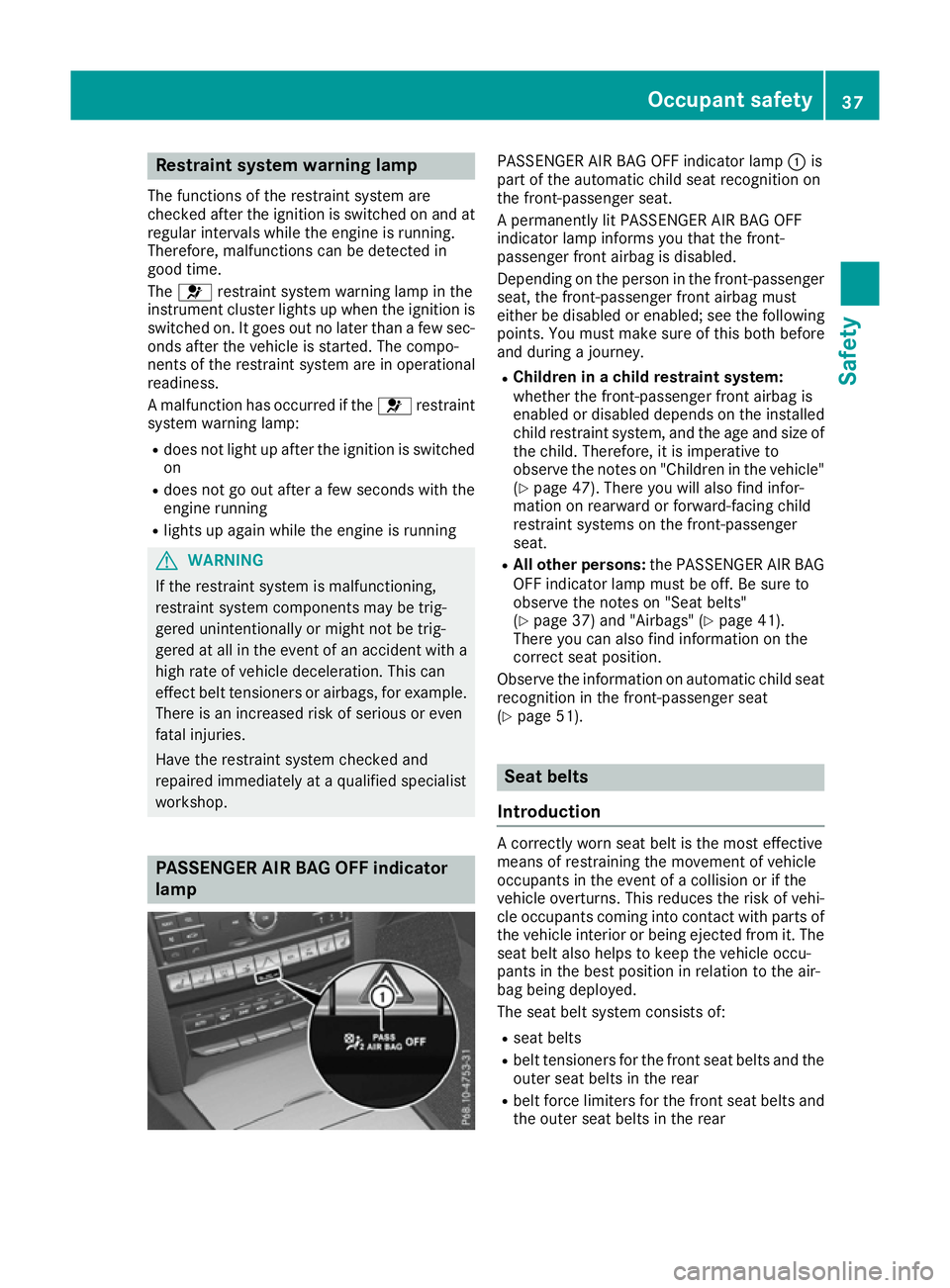
Restraint system warning lamp
The functions of the restraint system are
checked after the ignition is switched on and at
regular intervals while the engine is running.
Therefore, malfunctions can be detected in
good time.
The 6 restraint system warning lamp in the
instrument cluster lights up when the ignition is switched on. It goes out no later than a few sec-
onds after the vehicle is started. The compo-
nents of the restraint system are in operational
readiness.
A malfunction has occurred if the 6restraint
system warning lamp:
R does not light up after the ignition is switched
on
R does not go out after a few seconds with the
engine running
R lights up again while the engine is running G
WARNING
If the restraint system is malfunctioning,
restraint system components may be trig-
gered unintentionally or might not be trig-
gered at all in the event of an accident with a high rate of vehicle deceleration. This can
effect belt tensioners or airbags, for example. There is an increased risk of serious or even
fatal injuries.
Have the restraint system checked and
repaired immediately at a qualified specialist
workshop. PASSENGER AIR BAG OFF indicator
lamp PASSENGER AIR BAG OFF indicator lamp
:is
part of the automatic child seat recognition on
the front-passenger seat.
A permanently lit PASSENGER AIR BAG OFF
indicator lamp informs you that the front-
passenger front airbag is disabled.
Depending on the person in the front-passenger seat, the front-passenger front airbag must
either be disabled or enabled; see the following
points. You must make sure of this both before
and during a journey.
R Children in a child restraint system:
whether the front-passenger front airbag is
enabled or disabled depends on the installed
child restraint system, and the age and size of the child. Therefore, it is imperative to
observe the notes on "Children in the vehicle"
(Y page 47). There you will also find infor-
mation on rearward or forward-facing child
restraint systems on the front-passenger
seat.
R All other persons: the PASSENGER AIR BAG
OFF indicator lamp must be off. Be sure to
observe the notes on "Seat belts"
(Y page 37) and "Airbags" (Y page 41).
There you can also find information on the
correct seat position.
Observe the information on automatic child seat recognition in the front-passenger seat
(Y page 51). Seat belts
Introduction A correctly worn seat belt is the most effective
means of restraining the movement of vehicle
occupants in the event of a collision or if the
vehicle overturns. This reduces the risk of vehi- cle occupants coming into contact with parts of
the vehicle interior or being ejected from it. The
seat belt also helps to keep the vehicle occu-
pants in the best position in relation to the air-
bag being deployed.
The seat belt system consists of:
R seat belts
R belt tensioners for the front seat belts and the
outer seat belts in the rear
R belt force limiters for the front seat belts and
the outer seat belts in the rear Occupant safety
37Safety Z